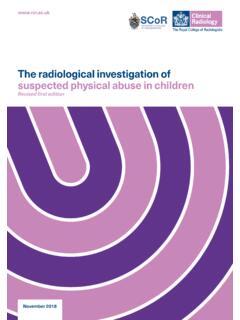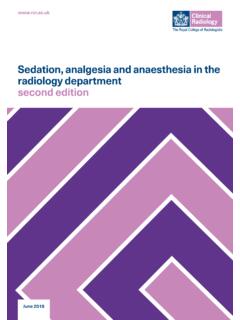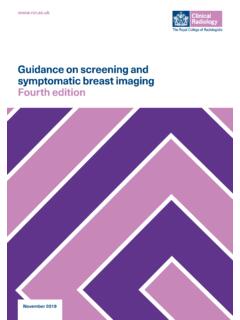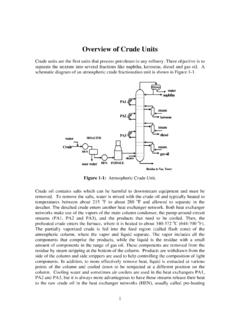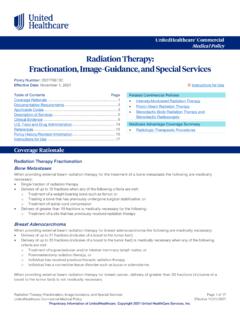Transcription of Radiotherapy dose fractionation Third edition
1 March 2019 Radiotherapy dose fractionation Third editionContentsForeword 3 Introduction 4 Oxford Centre for Evidence-based Medicine 81. Anal cancer 92. Bladder cancer 123. Breast cancer 164. Central nervous system (CNS) tumours 245. Gynaecological cancers 326. Head and neck cancer 407. Lung cancer 498. Lymphoma 589. Paediatric cancer 6510. Penile cancer 7611. Prostate cancer 8112. Rectal cancer 8813. Renal cancer 9414. Sarcoma 9615. Seminoma 10216. Skin cancer 10417. Upper gastrointestinal cancer 11018. Bone metastases 11619. Brain metastases 12020. Oligometastases 12621. Metastatic spinal cord compression (MSCC) 131 Acknowledgements 134 Change logDateChange20 November 2020 Head and neck chapter Page 44 Palliative Radiotherapy schedules recommendations box Second schedule updated to 8 Gy in 3 fractions over 3 weeks (Level C) Original schedule incorrectly stated 21 Gy in 3 fractions over 3 weeks (Level C)02 December 2020 Head and neck chapter Page 44 Palliative Radiotherapy schedules recommendations box Second schedule updated to 24 Gy in 3 fractions over 3 weeks (Level C) Previous iteration (in place 20 November 2020 until 02 December 2020) stated 8 Gy in 3 fractions over 3 weeks (Level C)3 Radiotherapy dose fractionation Third editionForewordThe Radiotherapy dose fractionation guidance, published in 2006, was heralded as the most important contribution that the Faculty has made to the practice of Radiotherapy in the UK.
2 It was certainly highly successful and remains the most widely accessed guidance document from the Faculty of Clinical Oncology of all time. This is a tribute to the original working party, their commitment to providing an evidence- rather than tradition-based document and widespread involvement of Fellows with extensive open consultation prior to second edition published in December 2016 reflected the changes in practice which had evolved in the previous decade. It remained faithful to the vision of the original document, focusing on clear evidence-based recommendations wherever possible. In total, 110 Fellows and a number of stakeholder groups contributed to the final version and we are grateful to all those who responded to the consultation. The Professional Support and Standards Board (PSSB) review all RCR publications on a regular basis to ensure they remain up to date. This Third edition has therefore been produced to take account of further published evidence.
3 Many thanks to PSSB members and other colleagues for their work in ensuring this edition is up to date. There are particular updates to the chapters on central nervous system tumours, paediatric cancer and brain metastases with smaller changes in many of the other sections. I would like to express particular thanks to Professor Peter Hoskin for so ably leading the development the second edition and this updated version and to members of his Working Group Dr Jeanette Dickson, Dr Raj Jena, Dr Robin Prestwich and Dr Vivek Misra for their extensive input and excellent contributions. Thanks are due also to the former RCR Officers who co-ordinated the second edition , Professor Roger Taylor and Dr David Bloomfield, and to Gillian Dollamore and Sarah Griffin at the RCR for all their tireless coordination, advice and document is available on the RCR website to enable easy and wide access. We hope it will meet with similar approval to its predecessors and will continue to provide a definitive guide to dose fractionation in the Tom Roques, Medical Director for Professional Practice, Clinical Oncology, The Royal College of Radiologists4 Radiotherapy dose fractionation Third editionIntroductionThe original guidance on Radiotherapy dose fractionation was introduced against a background of considerable variation in clinical practice across the that 2006 first edition there has been greater standardisation of treatment reflecting many influences, including more widespread appreciation of evidence-based practice, nationwide involvement in clinical trials addressing fractionation questions within the National Cancer Research Network and National Institute for Health Research and organisation of cancer care within networks charged with adherence to local and national these advances.
4 Radiotherapy in the UK remains under-resourced both in terms of equipment and manpower, as evidenced by our standing in the recently published Health Economics in Radiation Oncology (HERO) analyses of European Radiotherapy ,2,3 There is a continual challenge to upgrade linear accelerators to ensure modern therapy using intensity-modulated Radiotherapy (IMRT), image-guided Radiotherapy (IGRT) and stereotactic body radiotherapt (SBRT) can be delivered as routine to all appropriate patients in a system where resources for capital expenditure are severely has been important to recognise that, despite changes to redefine fractionation during the past decade, many clinical scenarios, particularly for palliative treatments, will still require conventional therapy techniques and this is also reflected in these guidelines to ensure a comprehensive cover of clinical second edition highlighted the role of combined-modality treatment and potential for stereotactic Radiotherapy .
5 Brachytherapy may form part of the patient s treatment but was not considered further as part of this Third edition includes particular updates on central nervous system tumours, brain metastases and paediatric cancers as well as smaller updates on other sections. This document has graded evidence according to guidelines defined by the Oxford Centre for Evidence-Based Medicine as shown of this documentThe Third edition has been reviewed by members of the RCR s Clinical Oncology Professional Support and Standards Board and the working party of the second edition to ensure that the guideline continues to reflect current practice at a time of rapid change in Radiotherapy technologies. Most of the guidance remains unchanged from the second edition which was subject to extensive peer review. The process for the review of this second edition , on which the content of this Third edition is based, is summarised below: First stage consultationReviewers, based on those who contributed to the 2006 document, two members of the RCR s Clinical Oncology Professional Support and Standards Board (PSSB) and additional site-specific experts, were invited to review the sections of the 2006 document relevant to their site specialty and to advise on current fractionation schedules and the new evidence base for stage consultation5 Radiotherapy dose fractionation Third editionEach chapter was revised by the working group, taking account of comments received from reviewers.
6 These revised chapters were sent to all those who had commented at the first stage of consultation and were also posted on the Clinical Oncology Online Fora on the RCR Clinical Oncology Fellows and members were notified by email of the review of the original document and invited to contribute their views on the revised chapters. A notice about the review was included in two editions of the RCR monthly news ebulletin. Third stage consultationFollowing further editing in light of comments received, revised chapters were sent to stakeholder groups: British Association of Head and Neck Oncologists British Thoracic Society British Uro-oncology Group Children s Cancer and Leukaemia Group National Cancer Research Institute (NCRI) Clinical and Translational Radiotherapy Research Working Group (CTRad) Radiotherapy Clinical Reference GroupThey were also sent to clinical oncology members of the following NCRI clinical studies groups: Bladder and renal cancer Breast cancer Brain tumour Colorectal cancer Gynaecological cancers Head and neck cancer Lung cancer Lymphoma Prostate cancer Sarcoma Skin cancer Testis cancer Upper gastrointestinal Comments received from the above were again reviewed by the working group, leading to a final draft of the second edition which was published in of guidance Third editionFor this Third edition , chapters were initially reviewed by the RCR s Clinical Oncology Professional Support and Standards Board, in consultation with other site-specialty experts as necessary.
7 The review was not intended as a full peer review, but rather as a sense check of the document to ensure it continued to contain accurate and up-to-date information. Suggested changes to the document were considered by Professor Peter Hoskin, lead author of the second edition , and the rest of the working party, and a final draft of this Third edition was agreed. Comparison with the Malthus model5 The Malthus model is an evidence-based Radiotherapy demand simulation tool, originally commissioned by the National Health Service in England (NHS England) in 2011. The model incorporates clinical decision trees which encode best practice for 22 different adult tumour types. The Radiotherapy indications were established by a review of published 6 Radiotherapy dose fractionation Third editionliterature and surveys of key opinion leaders. The most recent refresh of the clinical decision trees was undertaken in March 2014. The Malthus team has undertaken a sense check of fractionation regimens referenced in this document.
8 While a wider range of alternative fractionation regimens for specific indications are cited in this document, there is a high level of concordance in the cited fractionation regimens from both sources. The salient differences are as follows: Hypofractionation At release, the Malthus model defaulted to 2 Gray (Gy) per fraction regimens for curative indications with the exception of adjuvant breast Radiotherapy , where robust evidence for hypofractionation from the the UK Standardisation of Breast Radiotherapy (START) trial and other studies was ,6 The Malthus team acknowledged that stronger evidence now exists for hypofractionation in curative treatment of head and neck, and prostate cancer, as discussed in the relevant sections of this document. Palliative treatment of head and neck cancer The use of 40 Gy in ten fractions as a split course, 21 Gy in three fractions over three weeks and 14 Gy in four fractions were not included in the Malthus decision tree.
9 There is, however, a lack of high-quality evidence in this area and the regimens listed in the report are likely to reflect current practice from key opinion leaders in the , it is important to emphasise that this is not a comprehensive text on Radiotherapy . Limited background has been included to give each section context and where appropriate some detail of the evidence base from which the recommendations are derived has been given. We have deliberately avoided giving specific recommendations on treatment fields, volume or technique, which are considered to be outside the scope of this document. 7 Radiotherapy dose fractionation Third edition1. Borras JM, Lievens Y, Dunscombe P et al. The optimal utilization proportion of external beam Radiotherapy in European countries: An ESTRO-HERO analysis. Radiother Oncol 2015; 116(1): 38 44. 2. Borras JM, Barton M, Grau C et al. The impact of cancer incidence and stage on optimal utilization of Radiotherapy : Methodology of a population based analysis by the ESTRO-HERO project.
10 Radiother Oncol 2015; 116(1): 45 50. 3. Borras JM, Lievens Y, Barton M. How many new cancer patients in Europe will require Radiotherapy by 2025? An ESTRO-HERO analysis. Radiother Oncol 2016; 119(1): 5 (last accessed 22/9/16)5. Jena R, Round C, Mee T et al. The Malthus programme a new tool for estimating Radiotherapy demand at a local level. Clin Oncol (R Coll Radiol) 2012; 24(1): 1 Haviland JS, Owen JR, Dewar JA et al. START Trialists' Group. The UK Standardisation of Breast Radiotherapy (START) trials of Radiotherapy hypofractionation for treatment of early breast cancer: 10-year follow-up results of two randomised controlled trials. Lancet Oncol 2013; 14(11): 1086 dose fractionation Third edition1. (last accessed 22/9/16)Grades of recommendationA Consistent level 1 studiesB Consistent level 2 or 3 studies or extrapolations from level 1 studiesC Level 4 studies or extrapolations from level 2 or 3 studiesD Level 5 evidence or troublingly inconsistent or inconclusive studies of any level Extrapolations are where data is used in a situation that has potentially clinically important differences than the original study of evidence1a SR (with homogeneity*) of RCTs1b Individual RCT (with narrow confidence interval)1c All or none 2a SR (with homogeneity*) of cohort studies2b Individual cohort study (including low quality RCT; for example, <80% follow-up)2c Outcomes research.


